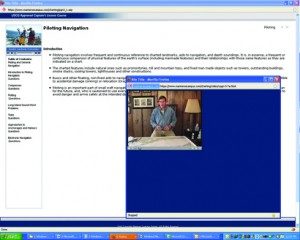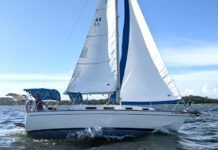
A little voice said check your ego at the door when I plunked down my $700 for the Mariners Learning Systems online course for OUPV, Masters 100-Ton Upgrade and Sailing Endorsement. After three decades covering ships and the sea in marine publishing, cutting my teeth in the company of luminaries like Bill Robinson and Bob Bavier, I considered myself pretty knowledgeable, but hardly cocky. Id say I have a good store of nautical information, but its like the game Trivial Pursuit-lots of unconnected bits that can be summoned as required. Id be the first to admit I could always know more-and adding bricks and mortar to the foundation never hurts. In the end I only proved my secret fear: Sometimes you don’t know what you don’t know. Cracking into the MLS online course work-absorbing the arcana of lights, shapes, sounds, firefighting, ranges, daymarks and bifurcations-was both humbling and illuminating.
On June 9, after an eager start back in October, I completed all required tests for my 100-ton masters license with sailing endorsement. To achieve this personal milestone, I took six test modules in March. I surpassed the required 90% on Rules of the Road, aced the sailing test (on penalty of getting keelhauled here at Practical Sailor) and pulled in a gentlemans 85% on deck general and navigation. I achieved similar results with the Masters upgrade. Then I met my nemesis. I bombed the plotting exam, stinking up the proctored test center with a putrid 50%. My head clearly wasnt in the game that day and I slunk back to my nocturnal online sessions to figure out where I went wrong. Thats when I discovered the real advantage of set-your-own-pace online learning. It was a simple matter to go back over course materials, identify the boneheaded mistakes I fell heir to, engage more problem sets and plan my revenge. Its important to realize that the difference between correct and incorrect responses on the Coast Guard plotting test might be four degrees and half a knot. Twenty years ago I survived an FAA check ride to get my pilots instrument rating with an examiner flying in the right seat, so I am not unused to the finer gotchas on federal testing. It was time to tighten up.
I spent a lot of time watching the Clooney-esque talent on the MLS plotting module videos and let the mechanics soak in. Then I hit the additional problem sets-hard-discovering that an inadequate grasp of deviation was bolluxing up my conversions from ships compass to true. This seemingly tiny lapse had a ripple effect across the broad sweep of my calculations-and loomed large in the final result. I called MLS for a little tutoring, but then discovered my errant ways on my own. It was time to get back on the horse.
Bottom line: I took the damnable plotting test for a second time, stewing and fretting over each of ten questions. They ranged in difficulty from a couple of no-brainers on chart notes and symbology, to a pair of dastardly set and drift problems that tested every aspect of plotting technique, from calculating military time differentials to time/speed/distance equations to course schedules. I spent twenty minutes divining the difference between two multiple choice responses separated by three-tenths of a minute of north latitude. I ran a couple of the trickier course and speed-made-good equations twice-and went over all my calculations with care. (Youre saying wed be on the reef by now after all this noodling.)
I turned in my exam and awaited my fate. The wizened mariner who proctored the exam called my name and I walked forward to get the news.
Congratulations captain, he said quietly with a nod and a shake of the hand. Then he showed me my score: 100%. Thats more like it.
So how does it feel to be put through a bit of a ringer? First, people who have been around boats and water since toddlerhood might think they know a lot more than they do (guilty as charged). A solid course that teaches the deep fundamentals of the lateral system and safety at sea is an eye-opener for even experienced sailors who want to develop nautical mastery. And the online environment was ideal for an individual with Type-A time demands. I found I could tackle this challenge a module at a time, and self assess and back track as needed. The series of quizzes, final exams and the proctored test offered the right mix of stresses and demands so the learning became engrained. One could argue that 80 hours in a classroom with a gifted teacher is more valuable than my prolonged online experience. However, taking a course away from home and office just wasnt in the cards for me. It came down to taking my Masters course online-or not at all. That, to me, is the real justification for this kind of distance learning. Going online opened the door.
I also re-learned something an old FAA flight examiner told me in decades past.
That license in your pocket isn’t the end, he said. Its really a license to learn.








































